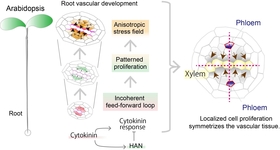Biological Science 2023/03/15
Compressive stress, oriented by cytokinin-regulated patterned proliferation, establishes the symmetry of tissue boundary in Arabidopsis root vascular tissue.
The generation and maintenance of tissue boundaries are fundamental to the development of functional organs in both plants and animals. In general, tissue boundaries are initially set among primordial cells, and their shapes and arrangements are refined during subsequent organ growth. In this process, cell migration plays a curtail role for boundary refinement in animal systems, however, plant tissue lacks such cell fluidity due to its cell walls. Despite significant progress in understanding the initial patterning of tissue boundaries in several plant organogenesis, whether and how boundary shape is regulated under the subsequent growth phase remains unknown in plants.
A research team led by Shunsuke Miyashima at the Nara Institute of Science and Technology (NAIST) has defined a mechanism for shaping the tissue boundary and refining its symmetry during Arabidopsis root vascular tissue development. "Localized proliferation regulated by the cytokinin signaling circuit is decoded into a globally oriented mechanical stress to symmetrize the plant vascular tissue boundary," he says.
Using laser cell ablation and mechanical simulation, the researchers demonstrated that positionally biased cell proliferation in vascular development generates anisotropic compressive stress field, smoothing and symmetrizing the boundary between two major cell-types in plant vascular tissue, xylem and procambium. As the molecular mechanism, the researchers found that the GATA transcription factor HANABA-TARANU (HAN) forms a feed-forward regulatory loop to cytokinin response to determine the position and frequency of cell proliferation, thereby distally and symmetrically restricting the source of mechanical stress to the boundary. The spatially constrained environment of plant vascular tissue efficiently entrains stress orientation among cells to produce a tissue-wide stress field, mechanically smoothing and symmetrizing the vascular cell-type boundary.
This work reveals a mechanism for shaping tissue boundaries during Arabidopsis root vascular tissue development. Through positionally biased cell proliferation, the cytokinin-HAN signaling circuit organizes anisotropic compressive stress field, which smooths and symmetrizes the tissue boundary. This work is unique such that it demonstrates the mechanical stress regulation occurs not only at adjacent cells, but also at distal locations in the tissue patterning. Although this mechanism is currently demonstrated in plant-based systems, it is likely that this mechanism also acts in animal tissues. Hence, this work sheds new light on the cell mechanics involved in morphogenesis in all multicellular organisms.
###
Resource
- Title: Patterned proliferation orients tissue-wide stress to control root vascular symmetry in Arabidopsis
- Authors: Motohiro Fujiwara, Miyu Imamura, Katsuyoshi Matsushita, Pawel Roszak, Takafumi Yamashino, Yoichiroh Hosokawa, Keiji Nakajima, Koichi Fujimoto, Shunsuke Miyashima
- Journal: Current Biology
- DOI: 10.1016/j.cub.2023.01.036
- Information about the Plant Developmental Signaling Laboratory can be found at the following website: https://bsw3.naist.jp/eng/courses/courses110.html





